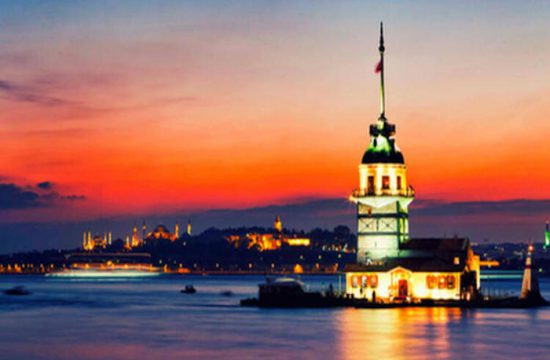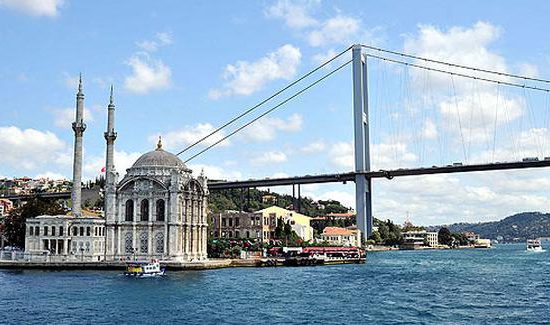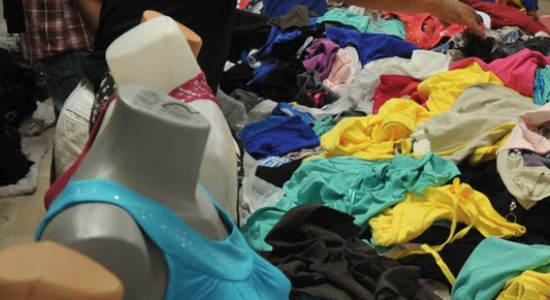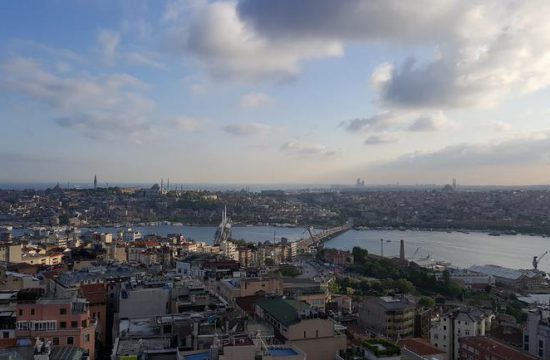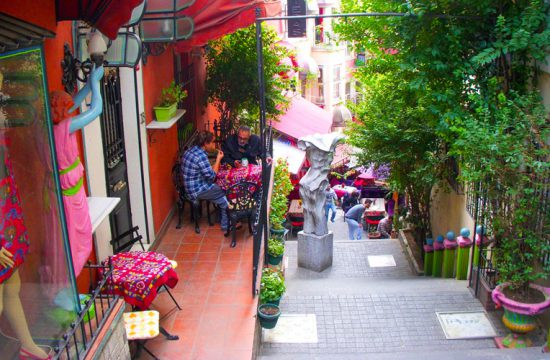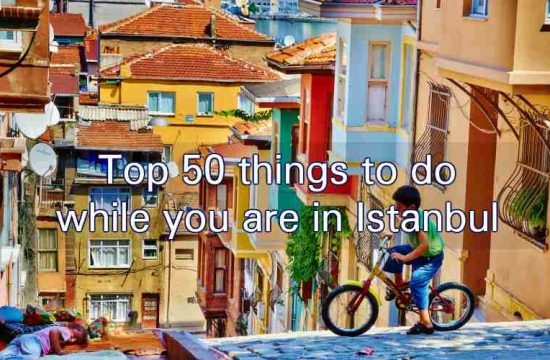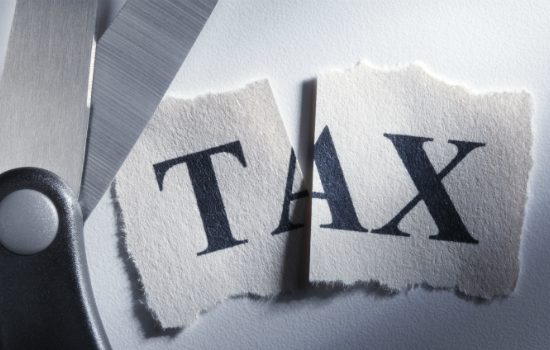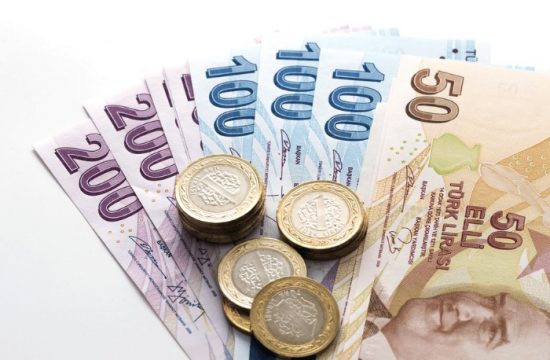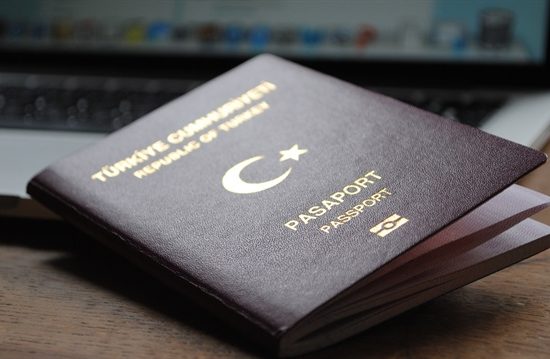Public transport
Istanbul’s public transit system can be difficult to figure out; maps are rare and you often have to transfer, and pay another fare, to get where you are going. However, if you put some effort into it, you can avoid taxis and not walk too much.
There is an extensive bus system, including city-run and private buses, as well as one high-speed Metrobüs line; an extensive light rail system including four Metro (underground) lines, four Tramvays (aboveground), two Fünikülers (ascending/descending), two mini-lines called Teleferik, and the Marmaray (underwater) lines; and the ferries which travel the Bosphorus.
An important supplement to all of this (particularly late at night) is the fleet of private dolmuş minivans, which follow prescribed routes and wait until they fill up before departing. They range in price from 2-8 lira (paid in cash), depending on how far you’re going. They run all night long, unlike most of the public transport lines. So if you find yourself stranded at Taksim at 4am, a dolmuş is your way home. Look for the yellow minivans, and ask them where they’re going (“néreye gidiyórsunuz?”).
Each time you use a tram, metro, bus, or boat on the public transport system, you will need to use a token (expensive) or a magnetic card (cheaper, see below). The small metal/plastic tokens cost 4 TL (July 2014) and can be bought at various ticket kiosks & machines at bus, railway and metro stations. Ticket fares across buses, trams and metros are at a flat rate (i.e. not dependent on how far you go). Only cash in Turkish lira is accepted at ticket kiosks of public transport, no credit cards or foreign currency. Also be aware that the Istanbul subway system does not offer transfer tickets and as such each new line requires a new fare, unless you use an an Istanbulkart
Istanbul Kart
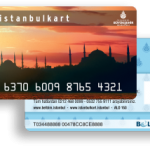
Buying an Istanbulkart is a good idea if you are in Istanbul for more than a day or two, and intend to use public transport. This is a plastic card that looks like a credit card. It can be used as a ticket on buses, trams, suburban trains, metro, some cross-Bosphorus ferries, and even some public toilets. You touch the Istanbulkart to a reader when you get on the bus or enter the tram/metro platform. The great part for groups of travellers is that you can buy only one and touch it as many times as there are passengers (unlike London’s Oyster card, there is no need to touch out). You can buy or refill them at designated booths located at any major bus, tram, to metro station, as well as some other places such as newspaper stands close to bus stops.
By Bus (İETT)
There are two types of public buses in Istanbul; those run by the private sector and those run by the city-owned İETT. You can differentiate these two types by their colors. Privately run buses are blue-green with yellow non-electronic destination signs while İETT-run buses come in many flavors including old red-blue ones, newer green ones and red double-deckers. The Akbil Transit Pass is valid universally while tickets that can be obtained in kiosks near bus stops for 1.40 TL are valid only on İETT buses and cash payment only on private buses, although if you get on an İETT bus the driver will normally accept cash (normally 1.50 TL but this is dependent entirely upon what the driver wishes to charge) and hand you his Akbil for you to use.
Recently installed Metrobüs, long hybrid buses running on their special lanes separated from all other traffic and thus saving lots of time in Istanbul’s usually congested roads, connect western suburb of Avcılar with Kadıköy in Asian Side via Bakırköy, Cevizlibağ which is just out of old city walls near Topkapı Gate, and Mecidiyeköy.
Most bus lines operate between 6AM and around midnight, usually with a reduced volume of services after 10PM. Some lines between major centres operate 24 hr, though, as is the Metrobüs, with about an hour intervals. After midnight, buses cost two tickets pp rather than the usual one. Buses and streetcars tend to be very crowded during rush hours, especially on Mondays and Fridays. That can also create opportunities for pickpockets.
24 hr Bus Lines:
73 Taksim Square-Ataturk International Airport
110 Taksim Square-Kadikoy
112 Taksim Square-Bostanci
25T Taksim Square-Sariyer
40 Taksim Square-Sariyer
89C Taksim Square-Basaksehir
E10 Kadikoy-Sabiha Gokcen International Airport
15F Kadikoy-Uskudar
130 Kadikoy-Tuzla
34A Sogutlucesme(Kadikoy)-Edirnekapi (Metrobus)
34 Avcilar-Zincirlikuyu (Metrobus)
As a tourist, you are most likely to use the tram and the metro in the Sultanahmet and Taksim area since there are no bus lines operating in the Sultanahmet area anymore.
By Metro
Istanbul’s first underground system dates back to 19th century, when the funicular subway “Tünel” was constructed to operate from Karaköy to Istiklal Street in 1875. The distance travelled was 573 metres. This is a good way to go up the hill from the Beyoğlu side of the Galata Bridge to the famous Istiklal Caddesi pedestrian street.
Starting in the 1990’s, a modern and extensive (and often confusing) light rail system has been constructed in all parts of the city. The newest (as of October 2014) addition is the Marmaray undersea tunnel, which crosses below the Bosphorus from the the Sultanahmet area to the Anatolian side. Underground lines are called “metro,” above ground lines are called “tram,” and there are also short, uphill lines called “füniküler,” two tiny “teleferik” lines, and the undersea Marmaray. There is also a high-speed bus called Metrobüs, complementary to this whole network.
There are four Metro lines, the first of which has two branches. The most useful to most tourists will be M1A which visits both Atatürk Airport and the Otogar Bus Station, and the M2 which passes near to Sultanahmet and travels to Galata/Taksim and beyond.
All lines are still being extended, but as of October 2014, they include:
M1A starts in Aksaray (west of Sultanahmet) and ends at Atatürk Airport, traveling via Emniyet-Fatih, Topkapı-Ulubatlı, Bayrampaşa-Maltepe, Sağmalcılar, Kocatepe, Otogar, Terazidere, Davutpaşa-YTÜ, Merter, Zeytinburnu, Bakırköy-İncirli, Bahçelievler, Ataköy-Şirinevler, Yenibosna, DTM İstanbul Fuar Merkezi, and finally Atatürk International Airport (Havalimanı)
M1B also starts in Aksaray and has the same stops as M1A until Otogar. After Otogar, it continues with Esenler, Menderes, Üçyüzlü, and ends Bağcılar Meydan.
M2 travels between Yenikapı (south of Sultanahmet) and Hacıosman, stopping at Vezneciler, Haliç, Şişhane (near Galata Tower), Taksim Square (north end of Beyoğlu), Osmanbey, Şişli-Mecidiyeköy, Gayrettepe, Levent, 4 Levent, Sanayi, İTÜ Ayazağa, Atatürk Oto Sanayi, Darüşşafaka, and finally Hacıosman.
M3 is the Kirazlı-Olimpiyat-Başakşehir line. All stops are in the far west of the European side, and therefore unlikely to be of use to tourists and visitors.
M4 goes from Kadıköy to Kartal on the Anatolian side, stopping at Ayrılık Çeşmesi, Acıbadem, Ünalan (aka Uzunçayır), Göztepe, Yenisahra, Kozyatağı, Bostancı, Küçükyalı, Maltepe, Huzurevi, Gülsuyu, Esenkent, Hastane-Adliye, Soğanlık, and finally Kartal.
There is also a funicular system connecting Taksim to Kabataş, where you can take ferries across the Bosphorus to the Anatolian side, and also transfer to trams bound for the old city (see below). Another funicular, called Tünel, connects Şişhane to Karaköy (the eastern side of the Galata Bridge).
Nowadays, most metro stations do not have a staffed ticket booth, so you will have to obtain your token from automatic token dispensers (called Jetonmatic). Insert coins (except 1 or 5 kuruş) up to 4 TL and then press the button marked onay (Turkish for “approval”, no English translations are given on all the machines).
A token costs 4 TL (around €1.30) on any urban rail in Istanbul.
Istanbul Metro and Tram
A tram (line # T1) connects Zeytinburnu (connection to the metro line to the airport) to Kabataş (connection to the underground funicular to Taksim). The line is 14km long, has 24 stations and serves many popular tourist sites (e.g. in Sultanahmet) and ferries (e.g. Eminönü). An entire trip takes 42 minutes.
There are two tram lines running on the same tracks, the line numbered as 38 in front of tram cars runs along the entire T1 line between Kabataş and Zeytinburnu, while significantly shorter line #47 runs between Eminönü and Cevizlibağ stations (the latter of which is abbreviated as C.bağ-A.Ö.Y. on the signage of tram cars). However, both lines call at stations that are of most interest to travellers through the Old City. During morning and evening rush hours every alternate tram runs as #47, while during the rest of the day, most run as #38.
Although you may use the same tokens (2 TL) or AKBİL on the metro and tram, you must pay another fare each time you change lines.
The tram was put in service in 1992 on standard gauge track with modern cars, connecting Sirkeci with Topkapi. The line was extended on one end from Topkapi to Zeytinburnu in March 1994 and, on the other end from Sirkeci to Eminönü in April 1996. On January 30, 2005 it was extended from Sirkeci to Kabataş crossing Golden Horn after 44 years again. 55 vehicles built by ABB run on the line. The daily transport capacity is 155,000 passengers.
Tramway stations are: Zeytinburnu, Mithatpaşa, Akşemsettin, Seyitnizam, Merkezefendi, Cevizlibağ, Topkapı, Pazartekke, Çapa, Fındıkzade, Haseki, Yusufpaşa, Aksaray, Laleli (Üniversite), Beyazıt (Kapalıçarşı), Çemberlitaş, Sultanahmet, Gülhane, Sirkeci, Eminönü (ferryboats), Karaköy, Tophane, Fındıklı, Kabataş.
Between Taksim and Kabatas, there is a modern underground funicular to connect this tram line to the Taksim metro. The tram is also connected to the southern metro line (for the Otogar and Ataturk Airport) at Aksaray station, though the metro and tram lines are a short walk from each other.
During morning and evening rush hours (roughly between 7AM-9AM and 5PM-7:30PM respectively), tram cars run jam-packed so if you intend to take it for a couple of stations down the way, don’t even bother—walking instead is not only less tiresome than standing in what is essentially more crowded than a sardine can, it’s also quicker as you will most likely be able to get in the second or even third tram calling at the station due to the crowd.
There are also two other tram lines linking residential and industrial suburbs in the northwest with the city centre: T2, which heads for Bağcılar, and T4 (which is more like metro-tram systems of northwestern Europe, as it lies underground for part of its route), which heads for Sultançiftliği, connecting to the Zeytinburnu and Topkapı stations of the T1 line respectively. However, these lines are of very little, if any, use to the average traveller.
By Taxi
Taxis are an easy and cheap way to get around. As of September 2016, start off rate is 3.40 TL (€1.1) and then 2.1 TL (€0.6) for each km afterwards. A one-way travel from Taksim Square to Sultanahmet costs approximately 10-15 TL. Tipping is generally unnecessary. Occasionally, drivers will refuse to start the meter and try to negotiate a fixed price (but most drivers will start taximeters at all times). You should avoid these cabs and simply take another one as you will almost certainly end paying too much. To be sure, before getting in, just ask “how much to go to …?” (most of the drivers understand basic English) since the price they tell then is quite accurate. Tell them then to put the taximeter on. Drivers do normally work with the taximeter, so they will not be surprised at all when you ask them to put it on. The price at the end will be quite close to the one they tell you at the beginning. There is now, as of October 2009, just one fare unit, it means, there is no extra fare at night.
Taxis that wait near a bus station are usually a tourist trap. They start the meter but charge you 20 TL at least. Emphasize to the driver that you will pay for the meter price before getting in. Do not buy their quick-sell tricks. Always try to stop a taxi that is passing by on the road or find a legitimate taxi stop.
Insist on going to the destination that you want because some drivers are payed by commission for each time they have someone go to a certain site.
Beware riding a taxi other than the “yellow-colored” ones since the other-colored taxis are registered under different cities and have a different rating system.
Be careful on what notes you hand them for payment; some drivers have tried to pretend that the 50 lira note that was handed was just a 5 lira note. Occasionally taxi drivers may actually also rip notes you give them, and tell you it is no good, in order to make you hand them a 50 lira note. So, make sure the notes are not ripped, and is actually the right one before you hand them over. Also, if you are not familiar with the city the taxi driver may drive a detour in order to charge you more.
Traffic can be very bad, it can take an hour for a few km through the old city. You might be better off taking the metro out of the old city and then a taxi from there.
Some important routes with distances and estimated taxi fares are :
Ataturk Airport (IST) – Taxim Square ~ 21 km. See taxi fare and directions
Ataturk Airport (IST) – Sultanahmet Square (Old City) ~ 18 km. See taxi fare and directions
Taxim Square – Sultanahmet (Old City) ~ 5,5 km. See taxi fare and directions
Sabiha Gokcen Airport (SAW) – Kadikoy (Chalcadonia) Ferry Terminal ~ 36 km. See taxi fare and directions
Esenler (Bus Terminal) – Topkapi Palace (Sultanahmet) ~ 10,5 km. See taxi fare and directions
Esenler (Bus Terminal) – Ataturk Airport (IST) ~ 15 km. See taxi fare and directions
By shared taxi[edit]
By shared taxi
Dolmuş (Turkish: “full”) is a shared taxi, travelling on a fixed route, which costs more than a city autobus but less than a normal taxi. They can carry up to 8 passengers. They are easy to recognize, because they also have the yellow painting as taxis and carry a Dolmus sign on its top. They will only start driving when all eight places are filled, which is also where the name derives from.
The main and most important routes for Dolmuses are :
Taksim – Eminönü (Taksim stop, near the Ataturk Cultural Center, in Taksim square)
Taksim – Kadıköy
Taksim – Bostanci
Taksim – Aksaray (Taksim stop, Tarlabasi Avenue, close to Taksim square)
Kadıköy – Bostanci (Bostanci stop, in front of the Bostanci ferry port)
Taksim – Tesvikiye (Taksim stop, in front of Patisserie Gezi, in Taksim square)
Beşiktaş – Nisantasi (Beşiktaş stop, in front of the Beşiktaş – Üsküdar ferry port)
Kadıköy – Üsküdar (Üsküdar stop, Near the Üsküdar – Beşiktaş and Üsküdar – Kabataş ferry port)
If you want the driver to make a stop, you can say İnecek var.(EE-neh-djek war!) (Someone’s getting out.) or Müsait bir yerde.(mU-sa-EEt bir yer-deh.) (At a convenient spot.).



